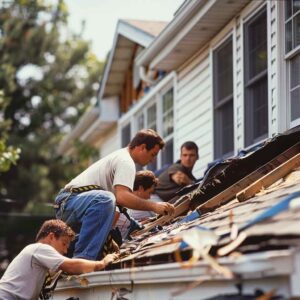Are you tired of dealing with pesky ice dams on your roof? Don’t worry, we’ve got you covered! In this article, our roofing contractors will show you how to remove those troublesome ice dams easily and safely.
From identifying the signs to using effective insulation techniques, we’ll guide you step-by-step.
With our tips, you’ll be able to prevent ice dams from forming and keep your roof in top shape. Say goodbye to those icy headaches and hello to a worry-free winter!
Tip 1: Identify the Signs of Ice Dams
Preventive measures are essential to avoid damage caused by ice dams. Identifying these signs early on can help you take necessary actions and prevent further problems.
One key sign is the presence of icicles hanging from the edge of your roof. These icicles can indicate the formation of ice dams.
Another sign to look out for is water leaking into your home, particularly in the attic or along the walls. This leakage can be a result of ice dams forcing water under the shingles.
If you notice these signs, it is crucial to seek professional assistance to address the issue promptly and prevent any further damage.
Tip 2: Safely Remove Accumulated Snow From Your Roof
To remove accumulated snow from your roof, you should carefully consider using a snow rake or hiring a professional. When using a snow rake, it’s important to take certain safety precautions. Make sure you have a sturdy ladder and wear appropriate footwear for traction.
Start at the edge of the roof and gently pull the rake towards you, taking care not to damage the shingles. Avoid standing directly under the snow you’re removing to prevent injury.
If you’re not comfortable doing this yourself or if your roof is too high, it’s best to hire professional services. They have the expertise and equipment to safely remove the snow without causing any damage to your roof or risking injury.
Tip 3: Implement Effective Insulation and Ventilation Techniques
Insulation is crucial as it helps maintain a consistent temperature in your attic, preventing warm air from escaping and melting the snow on your roof. This can be achieved by adding insulation to the floor of your attic, as well as insulating any exposed pipes or ductwork.
Good ventilation is equally important, as it allows for the proper exchange of air, preventing moisture buildup that can contribute to ice dam formation.
Make sure your attic has enough vents to allow for adequate airflow, and consider installing a ridge vent or soffit vents to improve ventilation.
By implementing these insulation and ventilation techniques, you can greatly reduce the risk of ice dams and protect your roof from potential damage.
Tip 4: Utilize Heat Cables to Melt Ice Dams Gradually
Using heat cables can help gradually melt ice dams on your roof. Here are four steps to effectively utilize heat cables for ice dam prevention:
- Choose the right heat cables: Select heat cables specifically designed for ice dam prevention. These cables are typically self-regulating, meaning they adjust their heat output based on the temperature.
- Plan the installation: Determine the areas where the ice dams are forming and plan the placement of the heat cables accordingly. Ideally, they should be installed along the roof’s eaves and in the valleys where ice dams tend to occur.
- Install the heat cables: Follow the manufacturer’s instructions for heat cable installation. Ensure that the cables are securely fastened to the roof and properly connected to a power source.
- Monitor and maintain: Regularly inspect the heat cables to ensure they are functioning properly. Remove any debris or snow that may hinder their effectiveness.





